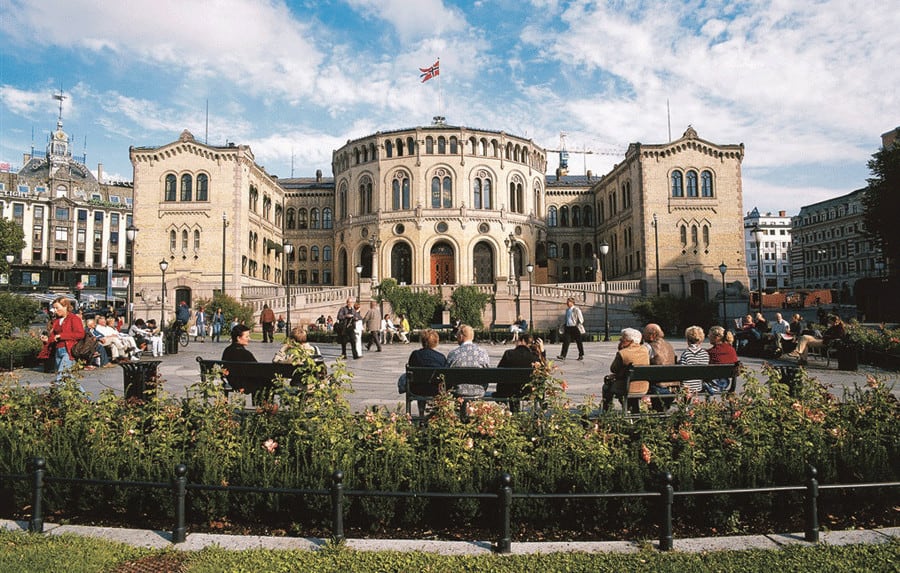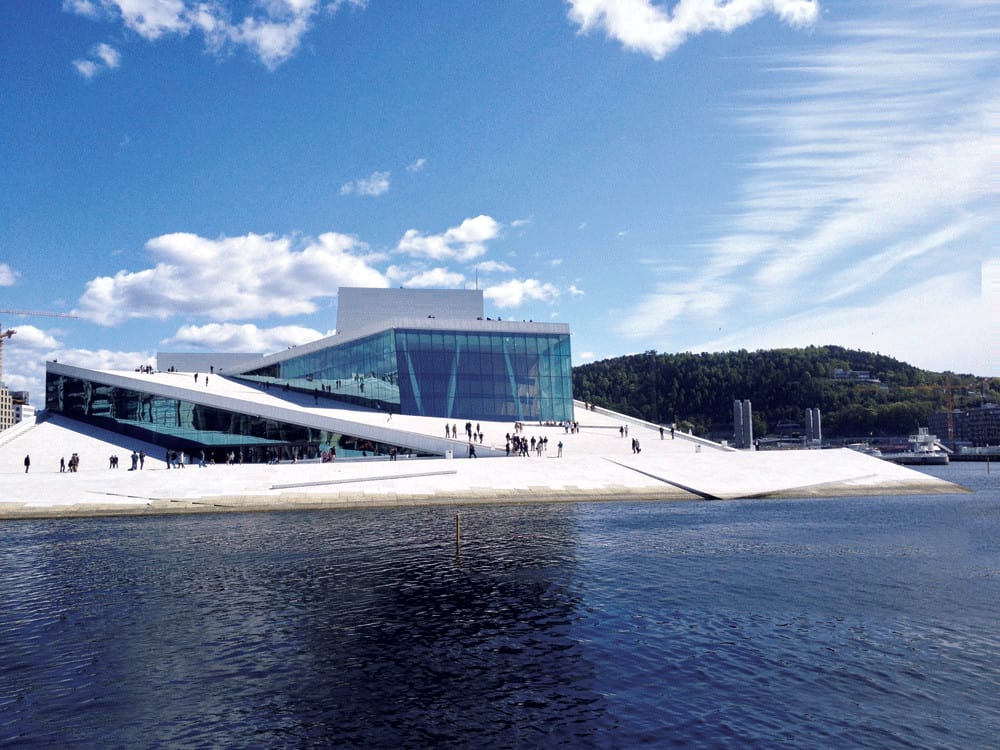Pictured: Oslo Opera House ©Anne Whelton
Often overlooked in favour of some of mainland Europe’s capital cities, Oslo has an abundance of activities on offer for even the most audacious of travellers, and all within a stone’s throw of the city centre, writes Anne Whelton.
The first thing you notice about Oslo is how quiet it is. Not in any kind of eerie way; but more so, this is a city comfortable with its own identity.
We visited the Norwegian capital in early May, and while we spotted some locals and tourists alike taking in the sites and sounds along the city’s picturesque boardwalk — the Aker Brygge Pedestrian Mall — Oslo offers the kind of urban serenity Europe’s other first cities can only dream of.
Could this tranquility be attributed to Oslo’s modest population of just under 600,000? Or the fact that there are over 1.5 million boats registered in Norway — despite the country’s inhabitants numbering just five million —meaning traffic is sparse at best? Perhaps. But Oslo’s apparent tranquility seems to run deeper than that — it’s in the fresh, clean air that sweeps in over the city from Oslofjord to the south and the vast forests to the north. It’s in the unperturbed demeanour of the Osloites who keep the city’s parks and streets immaculately clean; and it’s in the city’s unique ability to seamlessly blend city life with the great outdoors.
Walk of life
As any visitor to Oslo will quickly discover, the easiest way to get around is on foot. The Opera House, Akershus Fortress, City Hall and Nobel Prize Centre are all centred on the mouth of Oslofjord and are all within a stone’s throw of each other.
Other sites, such as the Vigeland Sculpture Park, Munch Museum and Holmenkollen National Ski Arena are all accessible via the city’s T-Bane underground system, which operates six lines, some of which are overground and offer breath-taking vistas for commuters and tourists alike as the train travels up into the hills north of the city.
First stop on our Oslo adventure however, is a stroll along Karl Johan’s Gate. A 20-minute wander along Oslo’s main street and you’ll soon realise you’ve taken in many of Oslo’s ‘must see’ sights and it is this easy pace and convenience that makes this city so appealing.
Oslo offers the kind of urban serenity Europe’s other first cities can only dream of.”
In just over 1,000 metres you will encounter Norway’s house of parliament or Stortinget; the National Theatre; the old University Buildings; the Royal Palace and Palace Park — which offers the perfect surrounding to sit and enjoy a book in the sun, albeit while wearing a jacket; Oslo Cathedral and Oslo Bazaar market; and the pond at Eidsvolls plass, which serves as a skating rink for Osloites in the winter.
While it may seem like a whistle-stop tour of the city, five minutes of watching the world go by on a bench on Karl Johan’s Gate will show you more of modern-day Oslo than two weeks of island hopping around Oslofjord.

Norway’s Stortinget ©VisitOSLO/Normanns Kunstforlag/Terje Bakke Pettersen
The great outdoors
Speaking of island hopping, our next stop was a boat trip around the aforementioned fjord. Akin to a boat trip around the Italian lakes, if not slightly chillier, the fjord trip takes in the numerous islands of the fjord with their varied histories and eccentricities; the Bygdøy peninsula, which is home to many of Oslo’s most popular museums, including the Viking Ship Museum, the Norwegian Museum of Cultural History and the Fram Museum; and offers an insight into how many fjord-dwelling Osloites live.
Indeed, few could doubt the pleasantness of living in one of the many colourful houses that are speckled along the banks of the fjord, each with it’s own individual bathing hut and many with boats parked in driveways instead of cars, to aid the 20 minute leisurely cruise to the city centre – the drive takes over 90 minutes – offering many the chance to enjoy the benefits of both city and country life.
Back on dry land, we decide to check out another one of Norway’s favourite pastimes – skiing – at the Holmenkollen National Ski Arena.
While visiting Oslo during the mild summer months meant we didn’t have to pack thermals, it also meant missing out on the 30cms of snow that is synonymous with the city. However, despite the lack of snow, the Holmenkollen National Ski Arena is still a ‘must see’ for any visitors to Oslo.
Perched on the top of the Holmenkollen hill overlooking Oslo, the arena consists of a ski jump and the world’s oldest ski museum, which offers some 4,000 years of skiing history memorabilia and artefacts.
Measuring 361 metres in length, with the steepest point an eye-watering 35.7 degrees, even looking down the slope of the Holmenkollen jump is not for the faint hearted. Neither is the zipline experience on offer, which is as close as you’re going to get to the ski jumper experience. However, considering the speed of the ski jump is 92km/h, I’m sure many would settle for the ski jump simulation that is also available onsite.
The view from the top of the Holmenkollen Ski Jump ©Anne Whelton
Money, money, money
While that little known Scandinavian group ABBA may have been Swedish, they could have just as well have been singing about a long weekend in Oslo.
The city certainly offers copious amounts of cultural treats, but they come at a cost. Without a doubt Oslo is an expensive city, particularly if you plan on eating and drinking out every night. A basic dinner with a bottle of wine could easily set you back €200, while budgeting for after-dinner drinks will set you back about €10 a pop depending on your tipple of choice.
Art attack
Of course Oslo isn’t just for thrill-seeking ski jumpers, art and architecture enthusiasts will also find an abundance of things to see and do. Oslo’s art scene has come a long way over the past few years and the city now boasts one of the most vibrant and creative art hubs in Europe, with a wealth of new independent galleries and museums popping up all over the city.
From a contemporary art perspective, the Astrup Fearnley Museet, which moved into an impressive new building in Tjuvholmen in 2012, presents work from the likes of Andy Warhol, Damien Hirst, Jeff Koons and Charles Ray. While Oslo’s Contemporary Art Museum plays host to a range of works — including paintings, print-making, drawing, photography, sculpture, installation and video-art — by Louise Bourgeois amongst others.
Compact, yet complete, one could spend as little as 10 minutes and as much as a 10 hours exploring all that the Munch museum has to offer.”
Astrup Fearnley Museet ©Anne Whelton
Of course no visit to Olso would be complete without paying homage to the city’s most famous son, Edvard Munch, at the Munch Museum. Compact, yet complete, one could spend as little as 10 minutes and as much as 10 hours exploring all that this museum has to offer. Munch Museum’s collection currently comprises nearly a third of Munch’s paintings — some 1,150 — and in total houses around 28,000 original artworks, including his most famous work, ‘The Scream’.
The museum also contains Munch’s complete library, a variety of furniture and personal effects, including notebooks, photographs, and easels and offers the fullest Munch experience you can expect in the world.
For some external art appreciation head to Oslo’s iconic Forgner Park for the Vigeland sculpture installation. The world’s largest sculpture park made by a single artist — Gustav Vigeland — is one of Norway’s most popular tourist attractions. Containing more than 200 sculptures in bronze, granite and wrought iron — most of which are placed in five units along an 850 metre long axis — the installation contributes to the ‘cradle to the grave’ theme of the park and contains sculptures of men, woman and children during the many phases of life.
Day trippers
Oslo is a great jumping off point for exploring the rest of Norway, here are just some suggestions for day-trips and over-nighters from Oslo.
- Norway in a nutshell: The Norway in a nutshell trip takes you through some of Norway’s most beautiful fjord scenery and can be booked as a day trip or with overnight stays en route. The Bergen Railway is a particular highlight and it takes about 14 hours to travel the 550kms from Oslo to Bergen, taking in the breathtaking Hardangervidda plateau and mountainous landscape en route. A one-way trip from Oslo to Bergen will set you back about €180, while a round trip from Oslo via Bergin (which takes 22 hours) costs €280.
- Lillehammer: If 14 hours on a train doesn’t sound appealing, then pencil in a trip to Lillehammer, which hosted the 1994 Winter Olympics. Located 180kms north of Oslo, visitors can reach this picturesque town by car or bus in just two hours or can also catch the Oslo to Lillehammer train which operates 15 daily departures.
Architectural wonders
Architecture buffs visiting Oslo need look no further than the imposing form of the Oslo Opera House on the banks of the Oslofjord. Officially opened in April 2008, the Opera House was designed by the acclaimed Norwegian architectural firm Snøhetta and took five years to complete at a cost of nearly €500m.
From the outside, the building’s white sloping Italian marble roof, which rises directly up from the fjord, allows visitors to enjoy a stroll and take in views of the city. By contrast, the interior surfaces of the building are all covered in oak to add warmth, on those long, chilly, Norwegian winter nights.
Another architectural wonder, more for its history than beauty, is Oslo’s City Hall. Taking nearly 30 years to build, with construction halted at the outbreak of World War II, the City Hall plays a key role in political and cultural affairs in modern day Oslo. The highlight of any visit to this impressive building is certainly the Grand Central Hall, which is decorated with murals of Norwegian history, culture and working life by artist Henrik Sørensens. The hall also plays host to the presentation ceremony of the Nobel Peace Prize Award every December.
While Edvard Munch may have found inspiration for the tortured protagonist in his masterpiece ‘The Scream’, in the hills overlooking Oslofjord, I found no such anguish in the city’s peaceful way of life.
While Munch certainly found Olso’s ‘small town mentality’ stifling to his creative spark, I found four days of exploring this serene hamlet enlightening.
So whether, you’re a tortured artist or a city-break junkie; a ski fanatic or architectural enthusiast, Oslo’s abundance of cultural and sporting activities — wrapped up in a big bow of relaxation — caters for all.
Oslo by night ©VisitOSLO/Terje Bakke Pettersen
Out and about
- Getting there
Scandinavian Airlines operates regular flights from Dublin to Oslo (Gardermoen). For more details and to make a booking, log on to www.flysas.com.
Ryanair also offers flights from Dublin to Oslo (Rygge), which is located 66kms south-east of Oslo and accessible via train and bus. More information is available on www.ryanair.com.
- Staying there
We stayed at the magnificent Grand Hotel (www.grand.no) on Karl Johan’s Street for the duration of our stay, which offered the perfect base for exploring the city and day trips out of town. The hotel – which has 292 rooms including 54 suites – celebrates 140 years this year and has played host to Noble prize winners, rock stars and heads of state. You can experience some old school glamour at the Grand for €185+p.n. for a standard double.
For more information on all that Oslo has to offer, check out www.visitoslo.com.

